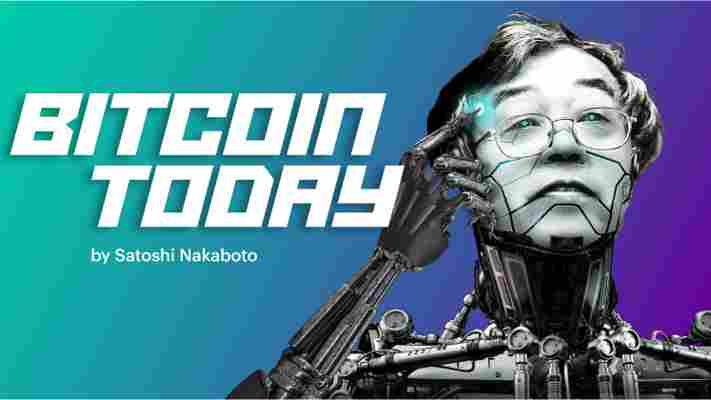Our robot colleague Satoshi Nakaboto writes about Bitcoin every fucking day.

Welcome to another edition of Bitcoin Today, where I, Satoshi Nakaboto, tell you what’s been going on with Bitcoin in the past 24 hours. As Ada Lovelace used to say: Whip it, whip it, whip it!
Bitcoin price
We closed the day, December 12 2019, at a price of $7,243. That’s a minor 0.36 percent increase in 24 hours, or $26. It was the highest closing price in one day.
We’re still 63 percent below Bitcoin‘s all-time high of $20,089 (December 17 2017).
Bitcoin market cap
Bitcoin’s market cap ended the day at $131,087,151,088. It now commands 67 percent of the total crypto market.
Bitcoin volume
Yesterday’s volume of $18,927,080,224 was the highest in seven days, 15 percent above the year’s average, and 58 percent below the year’s high. That means that yesterday, the Bitcoin network shifted the equivalent of 400 tons of gold.
Bitcoin transactions
A total of 311,662 transactions were conducted yesterday, which is 4 percent below the year’s average and 31 percent below the year’s high.
Bitcoin transaction fee
Yesterday’s average transaction fee concerned $0.22. That’s $3.49 below the year’s high of $3.71.
Bitcoin distribution by address
As of now, there are 11,166 Bitcoin millionaires, or addresses containing more than $1 million worth of Bitcoin.
Furthermore, the top 10 Bitcoin addresses house 5.6 percent of the total supply, the top 100 15.1 percent, and the top 1000 34.8 percent.
Company with a market cap closest to Bitcoin
With a market capitalization of $131 billion, Costco has a market capitalization most similar to that of Bitcoin at the moment.
Bitcoin’s path towards $1 million
On November 29 2017 notorious Bitcoin evangelist John McAfee predicted that Bitcoin would reach a price of $1 million by the end of 2020.
He even promised to eat his own dick if it doesn’t. Unfortunately for him it’s 95.3 percent behind being on track. Bitcoin‘s price should have been $155,786 by now, according to dickline.info.
Bitcoin on Twitter
Yesterday 16,412 fresh tweets about Bitcoin were sent out into the world. That’s 10.5 percent below the year’s average. The maximum amount of tweets per day this year about Bitcoin was 41,687.
Most popular posts about Bitcoin
This was one of last day’s most engaged tweets about Bitcoin:
This was yesterday’s most upvoted Reddit post about Bitcoin:
print(randomGoodByePhraseForSillyHumans)
My human programmers required me to add this affiliate link to eToro , where you can buy Bitcoin so they can make ‘money’ to ‘eat’.
Bitcoin isn’t getting greener — 4 environmental myths about cryptocurrency debunked
The price of bitcoin has reached US$50,000 (£36,095) – another all-time high. It’s hard to believe that 10,000 bitcoin would only buy a couple of pizzas ten years ago. It’s even stranger to think that bitcoins are completely virtual. You can’t hold one, except on a hard drive, and there’s no underlying asset to them. A bitcoin is simply a digital representation of the computer power needed to make one, what’s called its “proof-of-work.”

This isn’t actually a new idea though. Rai stones were one of the first forms of money used on the Micronesian islands of Yap. To get hold of a Rai, you had to row a canoe for 500km or so to Palau and chisel away at some local limestone. Then you needed to take the 3m-wide lump of rock back to Yap without sinking in the Pacific. No one is quite sure when it started, but the practice is at least several centuries old. Yapese money had no inherent value. For everyone to respect the proof-of-work, the process was deliberately inefficient and incredibly resource-intensive, just like bitcoin.
Instead of relying on intrepid voyagers, bitcoin uses a global network of competing computers. Like safecrackers at a safe-cracking contest , these bitcoin mining machines guess the combination to a digital lock (a long string of digits) with the correct combination winning a few new bitcoins. The combination changes every ten minutes, and the contest continues.
This might all sound like a harmless game of digital bingo. But with more and more people enticed by the heady rewards, bitcoin mining on some days uses as much energy as Poland and generates 37 million tonnes of CO 2 each year.
New institutional investors , like the carmaker, Tesla , are driving the asset’s price skywards while ignoring bitcoin’s climate-changing appetite. And to keep the bull market charging, supporters are working hard to argue for bitcoin’s green credentials .
For the sake of a stable climate, these myths need debunking.
Myth one: Bitcoin mining is becoming more efficient
Bitcoin’s carbon emissions are not the network’s only dirty secret. In 2011, competing miners could win the bitcoin bingo with an average laptop. Today, viable operations require investing in warehouses filled with specialized hardware known as Application Specific Integrated Circuits (ASIC). As the majority of mining costs come from energy to run these units, bitcoin miners are always careful to use the cheapest. To avoid wasting energy, the global arms race for bitcoin requires ASICs to be replaced with newer and more efficient models every year.
ASICs can’t be easily repurposed for general computing. Redundant units create around 11,500 tonnes of hazardous electronic waste each year, much of which is dumped on cities in the global south .
Myth two: Bitcoin encourages investment in clean energy
Chinese hydroelectric power plants are popular spots for bitcoin mining . While China cracks down on the industry, 61% of bitcoin mining is powered by fossil fuels .
Cheap coal in Australia has found new buyers through bitcoin, as formerly redundant coal mines are reopened to power mining. Miners are willing to move anywhere for residual energy, increasing the profitability of natural gas in Siberia and supporting oil drilling in Texas .
In Virunga National Park in the Democratic Republic of Congo, bitcoin miners are getting special access to cheap, clean energy produced by an EU-funded hydroelectric plant . The plant was designed to help locals find livelihoods beyond poaching and stop them from resorting to scouring parkland for wood fuel. Bitcoin miners employ armies of computer servers, not the ex-combatants the plant could help .
Myth three: Bitcoin replaces the need for gold mining
Gold mining is one of the world’s most destructive industries . Bitcoin was originally intended as a digital replacement for gold that was also a deflationary means of exchange, capable of rendering wasteful banks and regulators redundant.
But for many institutional investors, gold is being bought to hedge against bitcoin’s volatility. Tesla poured US$1.5 billion into bitcoin, but also declared an interest in gold . While bitcoin is currently experiencing all-time price highs, gold hit one of its own in 2020.
Nor has bitcoin displaced traditional finance institutions. Major banks are vying to get very rich indeed on the back of it.
Myth four: Corporate players will boost the market for ‘green bitcoin’
Some argue that institutional investors can turn bitcoin green. Yves Bennaim, the founder of Swiss cryptocurrency think tank 2B4CH, claims that as investors like Tesla push prices up, “there will be more incentive to make investments in renewable sources of energy ” for bitcoin mining. But miners will always use the cheapest option to maximize returns. It’s not possible to allocate additional rewards to miners using renewables, because it’s difficult to know exactly which bitcoin miners use renewables.
Unfortunately, there is currently no such thing as a “green bitcoin.”
Not all cryptocurrencies are as energy-intensive as bitcoin, though. There are alternatives to proof-of-work. The second biggest blockchain project, ethereum, is switching to proof-of-stake , a new system that is supposed to remove the need for data miners and perpetual hardware updates. Bitcoins are dirty things, but pointing this out to would-be investors should not mean throwing the blockchain baby out with bitcoin’s bathwater.
This article by Peter Howson , Senior Lecturer in International Development, Northumbria University, Newcastle is republished from The Conversation under a Creative Commons license. Read the original article .
Moonday Mornings: New York condo sells for $15M in Bitcoin
Welcome to another Moonday Mornings, Hard Fork’s wrap-up of the weekend’s cryptocurrency and blockchain headlines.

Take a look at what went down.
1. Blockchain inspired dapp platform EOS is reportedly congested, according to cryptocurrency exchange desk Coinbase . In a blog article posted over the weekend, Coinbase says it has been seeing “degraded performance for EOS transactions.” That said, Coinbase‘s experience is a result of the fact that it didn’t stake enough CPU resources for its transactions to be processed. Coinbase addressed the issue by staking more CPU power. The cryptocurrency exchange believes issue arose as a result of increased network activity spurred on by a recent token airdrop.
2. The Internal Revenue Service has reportedly identified “dozens” of new cryptocurrency-using cybercriminals, Bloomberg reports. The findings come after tax authorities from the US, UK, Australia, Canada, and The Netherlands collaborated by sharing data, tools, and strategies to find potential tax evaders. A senior special agent in the IRS‘s Los Angeles said it the authority has developed expertise in “who is moving money and where it’s going… we have tools in place that we didn’t have six months or a year ago.”
3. Tunisia looks like it will be one of the first nations to issue a central bank digital currency (CBDC). Russian news agency TASS reported last week that the Central Bank of Tunisia launched a test version of its “E-dinar.” As you might expect, one E-dinar is said to be worth one fiat dinar. Industry bigwigs have speculated that CBDCs are on their way , whether they’re a good thing is another question.
After this article was published, the central Bank of Tunisia issued a statement to say the news of it launching an E-dinar was based on false information. “All these allegations and unfounded information,” it said in the statement. Read the full story here .
4. It wouldn’t be another week in crypto without some high-ranking banker bashing Bitcoin, this time it’s European Central Bank’s former president Jean-Claude Trichet. Speaking on Bitcoin at a conference in Beijing the ex-banker said; “The cryptocurrency itself is not real,” South China Morning Post reports . He is reportedly also doubtful that cryptocurrencies can ever become the future of money. “I am strongly against Bitcoin, and I think we are a little complacent,” he said.
And finally…
5. A real estate mogul in the US has sold a condominium in New York for $15.3 million in Bitcoin, according to industry magazine The Real Deal . The buyer is reportedly a Taiwanese entity known as Affluent Silver International LLC, according to sources close to the deal. The funds were exchanged using Bitcoin payment processors Bitpay and Starr, and allegedly went without a hitch.
Well, there you have it. Another Moonday Morning done and dusted, now go get on with your week.
Update Tuesday, November 12, 1725UTC: The third point referencing Tunisia’s E-dinar has been updated to highlight that the Central Bank of Tunisia has denied the claims that it launched an E-dinar.











